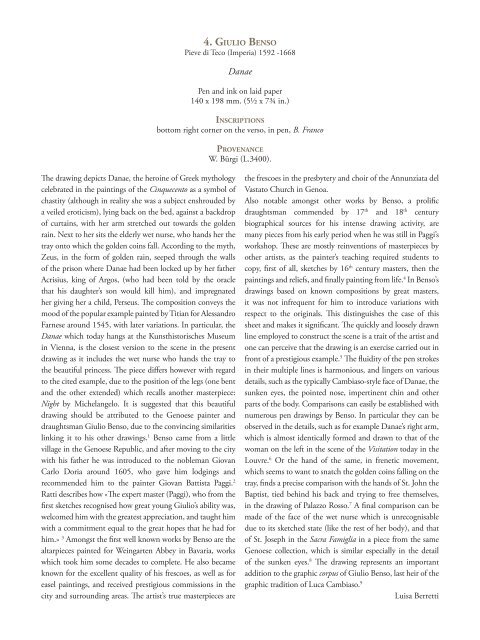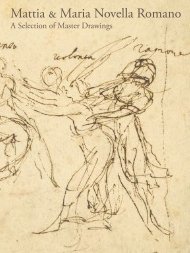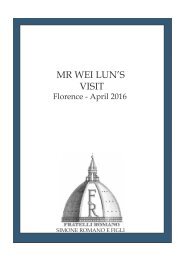A Selection of master drawings 2014
- No tags were found...
You also want an ePaper? Increase the reach of your titles
YUMPU automatically turns print PDFs into web optimized ePapers that Google loves.
4. Giulio Benso<br />
Pieve di Teco (Imperia) 1592 -1668<br />
Danae<br />
Pen and ink on laid paper<br />
140 x 198 mm. (5½ x 7¾ in.)<br />
Inscriptions<br />
bottom right corner on the verso, in pen, B. Franco<br />
Provenance<br />
W. Bürgi (L.3400).<br />
The drawing depicts Danae, the heroine <strong>of</strong> Greek mythology<br />
celebrated in the paintings <strong>of</strong> the Cinquecento as a symbol <strong>of</strong><br />
chastity (although in reality she was a subject enshrouded by<br />
a veiled eroticism), lying back on the bed, against a backdrop<br />
<strong>of</strong> curtains, with her arm stretched out towards the golden<br />
rain. Next to her sits the elderly wet nurse, who hands her the<br />
tray onto which the golden coins fall. According to the myth,<br />
Zeus, in the form <strong>of</strong> golden rain, seeped through the walls<br />
<strong>of</strong> the prison where Danae had been locked up by her father<br />
Acrisius, king <strong>of</strong> Argos, (who had been told by the oracle<br />
that his daughter’s son would kill him), and impregnated<br />
her giving her a child, Perseus. The composition conveys the<br />
mood <strong>of</strong> the popular example painted by Titian for Alessandro<br />
Farnese around 1545, with later variations. In particular, the<br />
Danae which today hangs at the Kunsthistorisches Museum<br />
in Vienna, is the closest version to the scene in the present<br />
drawing as it includes the wet nurse who hands the tray to<br />
the beautiful princess. The piece differs however with regard<br />
to the cited example, due to the position <strong>of</strong> the legs (one bent<br />
and the other extended) which recalls another <strong>master</strong>piece:<br />
Night by Michelangelo. It is suggested that this beautiful<br />
drawing should be attributed to the Genoese painter and<br />
draughtsman Giulio Benso, due to the convincing similarities<br />
linking it to his other <strong>drawings</strong>. 1 Benso came from a little<br />
village in the Genoese Republic, and after moving to the city<br />
with his father he was introduced to the nobleman Giovan<br />
Carlo Doria around 1605, who gave him lodgings and<br />
recommended him to the painter Giovan Battista Paggi. 2<br />
Ratti describes how «The expert <strong>master</strong> (Paggi), who from the<br />
first sketches recognised how great young Giulio’s ability was,<br />
welcomed him with the greatest appreciation, and taught him<br />
with a commitment equal to the great hopes that he had for<br />
him.» 3 Amongst the first well known works by Benso are the<br />
altarpieces painted for Weingarten Abbey in Bavaria, works<br />
which took him some decades to complete. He also became<br />
known for the excellent quality <strong>of</strong> his frescoes, as well as for<br />
easel paintings, and received prestigious commissions in the<br />
city and surrounding areas. The artist’s true <strong>master</strong>pieces are<br />
the frescoes in the presbytery and choir <strong>of</strong> the Annunziata del<br />
Vastato Church in Genoa.<br />
Also notable amongst other works by Benso, a prolific<br />
draughtsman commended by 17 th and 18 th century<br />
biographical sources for his intense drawing activity, are<br />
many pieces from his early period when he was still in Paggi’s<br />
workshop. These are mostly reinventions <strong>of</strong> <strong>master</strong>pieces by<br />
other artists, as the painter’s teaching required students to<br />
copy, first <strong>of</strong> all, sketches by 16 th century <strong>master</strong>s, then the<br />
paintings and reliefs, and finally painting from life. 4 In Benso’s<br />
<strong>drawings</strong> based on known compositions by great <strong>master</strong>s,<br />
it was not infrequent for him to introduce variations with<br />
respect to the originals. This distinguishes the case <strong>of</strong> this<br />
sheet and makes it significant. The quickly and loosely drawn<br />
line employed to construct the scene is a trait <strong>of</strong> the artist and<br />
one can perceive that the drawing is an exercise carried out in<br />
front <strong>of</strong> a prestigious example. 5 The fluidity <strong>of</strong> the pen strokes<br />
in their multiple lines is harmonious, and lingers on various<br />
details, such as the typically Cambiaso-style face <strong>of</strong> Danae, the<br />
sunken eyes, the pointed nose, impertinent chin and other<br />
parts <strong>of</strong> the body. Comparisons can easily be established with<br />
numerous pen <strong>drawings</strong> by Benso. In particular they can be<br />
observed in the details, such as for example Danae’s right arm,<br />
which is almost identically formed and drawn to that <strong>of</strong> the<br />
woman on the left in the scene <strong>of</strong> the Visitation today in the<br />
Louvre. 6 Or the hand <strong>of</strong> the same, in frenetic movement,<br />
which seems to want to snatch the golden coins falling on the<br />
tray, finds a precise comparison with the hands <strong>of</strong> St. John the<br />
Baptist, tied behind his back and trying to free themselves,<br />
in the drawing <strong>of</strong> Palazzo Rosso. 7 A final comparison can be<br />
made <strong>of</strong> the face <strong>of</strong> the wet nurse which is unrecognisable<br />
due to its sketched state (like the rest <strong>of</strong> her body), and that<br />
<strong>of</strong> St. Joseph in the Sacra Famiglia in a piece from the same<br />
Genoese collection, which is similar especially in the detail<br />
<strong>of</strong> the sunken eyes. 8 The drawing represents an important<br />
addition to the graphic corpus <strong>of</strong> Giulio Benso, last heir <strong>of</strong> the<br />
graphic tradition <strong>of</strong> Luca Cambiaso. 9<br />
Luisa Berretti





